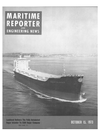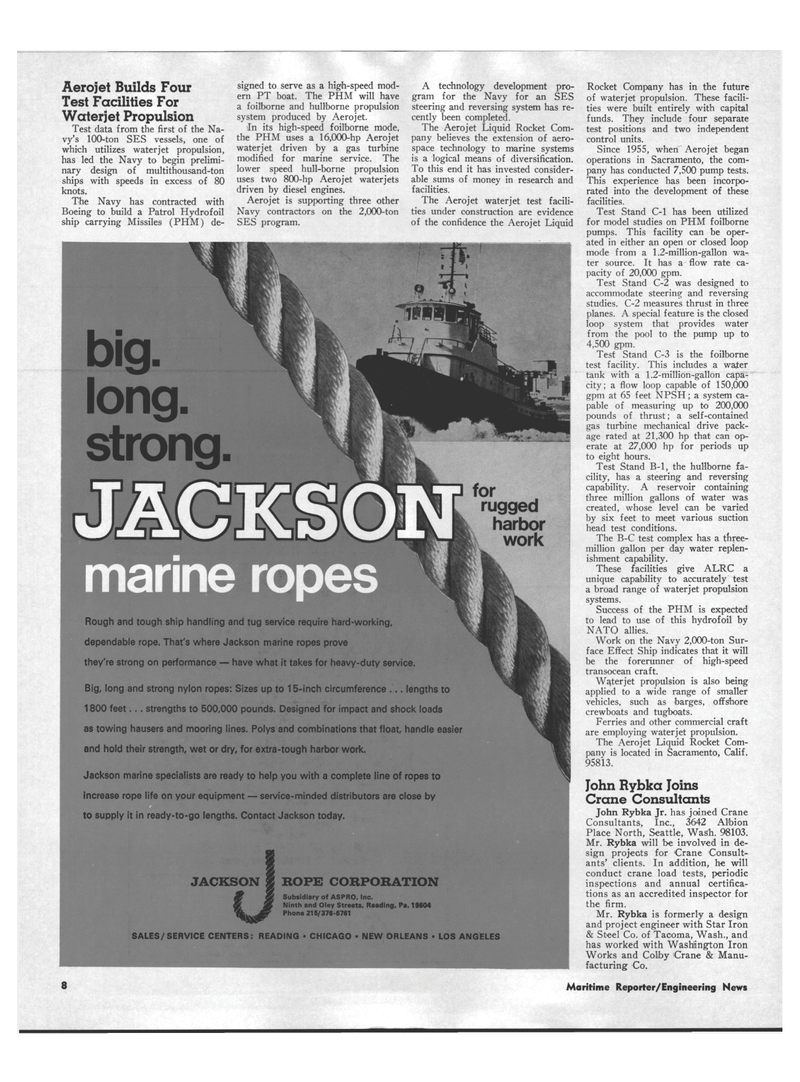
Page 6: of Maritime Reporter Magazine (October 15, 1973)
Read this page in Pdf, Flash or Html5 edition of October 15, 1973 Maritime Reporter Magazine
Aerojet Builds Four
Test Facilities For
Waterjet Propulsion
Test data from the first of the Na- vy's 100-ton SES vessels, one of which utilizes waterjet propulsion, has led the Navy to begin prelimi- nary design of multithousand-ton ships with speeds in excess of 80 knots.
The Navy has contracted with
Boeing to build a Patrol Hydrofoil ship carrying Missiles (PHM) de- signed to serve as a high-speed mod- ern PT boat. The PHM will have a foilborne and hullborne propulsion system produced by Aerojet.
In its high-speed foilborne mode, the PHM uses a 16,000-hp Aerojet waterjet driven by a gas turbine modified for marine service. The lower speed hull-borne propulsion uses two 800-hp Aerojet waterjets driven by diesel engines.
Aerojet is supporting three other
Navy contractors on the 2,000-ton
SES program.
A technology development pro- gram for the Navy for an SES steering and reversing system has re- cently been completed.
The Aerojet Liquid Rocket Com- pany believes the extension of aero- space technology to marine systems is a logical means of diversification.
To this end it has invested consider- able sums of money in research and facilities.
The Aerojet waterjet test facili- ties under construction are evidence of the confidence the Aerojet Liquid
Rocket Company has in the future of waterjet propulsion. These facili- ties were built entirely with capital funds. They include four separate test positions and two independent control units.
Since 1955, when Aerojet began operations in Sacramento, the com- pany has conducted 7,500 pump tests.
This experience has been incorpo- rated into the development of these facilities.
Test Stand C-l has been utilized for model studies on PHM foilborne pumps. This facility can be oper- ated in either an open or closed loop mode from a 1.2-million-gallon wa- ter source. It has a flow rate ca- pacity of 20,000 gpm.
Test Stand C-2 was designed to accommodate steering and reversing studies. C-2 measures thrust in three planes. A special feature is the closed loop system that provides water from the pool to the pump up to 4,500 gpm.
Test Stand C-3 is the foilborne test facility. This includes a water tank with a 1.2-million-gallon capa- city; a flow loop capable of 150,000 gpm at 65 feet NPSH; a system ca- pable of measuring up to 200,000 pounds of thrust; a self-contained gas turbine mechanical drive pack- age rated at 21,300 hp that can op- erate at 27,000 hp for periods up to eight hours.
Test Stand B-l, the hullborne fa- cility, has a steering and reversing capability. A reservoir containing three million gallons of water was created, whose level can be varied by six feet to meet various suction head test conditions.
The B-C test complex has a three- million gallon per day water replen- ishment capability.
These facilities give ALRC a unique capability to accurately test a broad range of waterjet propulsion systems.
Success of the PHM is expected to lead to use of this hydrofoil by
NATO allies.
Work on the Navy 2,000-ton Sur- face Effect Ship indicates that it will be the forerunner of high-speed transocean craft.
Waterjet propulsion is also being applied to a wide range of smaller vehicles, such as barges, offshore crewboats and tugboats.
Ferries and other commercial craft are employing waterjet propulsion.
The Aerojet Liquid Rocket Com- pany is located in Sacramento, Calif. 95813.
John Rybka Joins
Crane Consultants
John Rybka Jr. has joined Crane
Consultants, Inc., 3642 Albion
Place North, Seattle, Wash. 98103.
Mr. Rybka will be involved in de- sign projects for Crane Consult- ants' clients. In addition, he will conduct crane load tests, periodic inspections and annual certifica- tions as an accredited inspector for the firm.
Mr. Rybka is formerly a design and project engineer with Star Iron & Steel Co. of Tacoma, Wash., and has worked with Washington Iron
Works and Colby Crane & Manu- facturing Co. marine ropes
Rough and tough ship handling and tug service require hard-working, dependable rope. That's where Jackson marine ropes prove they're strong on performance — have what it takes for heavy-duty service.
Big, long and strong nylon ropes: Sizes up to 15-inch circumference ... lengths to 1800 feet... strengths to 500,000 pounds. Designed for impact and shock loads as towing hausers and mooring lines. Polys and combinations that float, handle easier and hold their strength, wet or dry, for extra-tough harbor work.
Jackson marine specialists are ready to help you with a complete line of ropes to increase rope life on your equipment — service-minded distributors are close by to supply it in ready-to-go lengths. Contact Jackson today.
JACKSON Z ROPE CORPORATION ^ Subsidiary of ASPRO. Inc.
Ninth and Oley Streets, Reading, Pa. 19604
Phone 215/376-6761
SALES/SERVICE CENTERS: READING • CHICAGO • NEW ORLEANS • LOS ANGELES 14
Maritime Reporter/Engineering News

 5
5

 7
7
